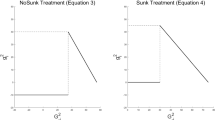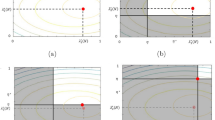Abstract
One important determinant of voluntary contributions to public goods is the value of the public good relative to that of the forgone private good. Isaac, Walker and Thomas (1984) formalized this relation in the Marginal Per Capita Return (MPCR) and demonstrated its influence on the provision of linear public goods. This paper develops a parallel concept, in the context of a threshold public good, the Step Return (SR). After providing a meta-analysis of the effect of SR in previous experiments, we compare contributions in threshold public goods games with low, medium and high SRs. Results show that subjects respond to the SR in this setting just as they respond to the MPCR in the linear public goods setting: higher SRs lead to more contributions.
Similar content being viewed by others
References
Andreoni, J. (1990). “Impure Altruism and Donations to Public Goods: A Theory of Warm-Glow Giving?” Economic Journal. 100, 464–477.
Asch, P., Gigliotti, G., and Polito, J. (1993). “Free Riding with Discrete and Continuous Public Goods: Some Experimental Evidence.” Public Choice. 77, 293–305.
Bagnoli, M. and Lipman, B. (1989). “Provision of Public Goods: Fully Implementing the Core through Private Contributions.” Review of Economic Studies. 56, 583–601.
Bagnoli, M. and McKee, M. (1991). “Voluntary Contributions Games: Efficient Private Provision of Public Goods.” Economic Inquiry. 29, 351–366.
Cadsby, C. and Maynes, E. (1998a). “Choosing between a Socially Efficient and Free-Riding Equilibrium: Nurses versus Economics and Business Students.” Journal of Economic Behavior and Organization. 37, 183–192.
Cadsby, C. and Maynes, E. (1998b). “Gender and Free Riding in a Threshold Public Goods Game: Experimental Evidence.” Journal of Economic Behavior and Organization. 34, 603–620.
Coats, J. and Gronberg, T. (1996). “Provision of Discrete Public Goods: An Experimental Investigation of Alternative Institutions.” Working Paper, Texas A&M University.
Croson, R. and Marks, M. (1998). “Identifiability of Individual Contributions in a Threshold Public Goods Experiment.” Journal of Mathematical Psychology. 42, 167–190.
Croson, R. and Marks, M. (1999). “The Effect of Recommended Contributions on the Voluntary Provision of Public Goods.” Working Paper, 98-02-04 OPIM, The Wharton School, University of Pennsylvania.
Davis, D. and Holt, C. (1993). Experimental Economics. Princeton University Press, Princeton.
Dawes, R., Orbell, J., Simmons, R., and van de Kragt, A. (1986). “Organizing Groups for Collective Action.” American Political Science Review. 80, 1171–1185.
Erev, I. and Rapoport, A. (1990). “Provision of Step-Level Public Goods: The Sequential Contribution Mechanism.” Journal of Conflict Resolution. 34, 401–425.
Greene, W. (1990). Econometric Analysis. Macmillan Publishing Company, New York.
Isaac, M., Schmidtz, D., and Walker, J. (1989). “The Assurance Problem in a Laboratory Market.” Public Choice. 62, 217–236.
Isaac, M., Walker, J., and Thomas, S. (1984). “Divergent Evidence on Free-riding: An Experimental Examination of Possible Explanations.” Public Choice. 43, 113–149.
Johnson, L. (1996). “Bayesian Nash Equilibria in a Public-Goods Experiment with a Provision Point.” Working Paper, Rutgers University.
Ledyard, J. (1995). “Public Goods: A Survey of Experimental Results.” In John Kagel and Alvin Roth (eds.), The Handbook of Experimental Economics. Princeton University Press, Princeton; pp. 111–194.
Marks, M. and Croson, R. (1998). “Alternative Rebate Rules in the Provision of a Threshold Public Good: An Experimental Investigation.” Journal of Public Economics. 67, 195–220.
Marks, M. and Croson, R. (1999). “The Effect of Incomplete Information in a Threshold Public Goods Experiment.” Public Choice. 99, 103–118.
Mysker, M., Olson, P., and Williams, A. (forthcoming). “The Voluntary Provision of a Threshold Public Good: Further Experimental Results.” Research in Experimental Economics.
Offerman, T., Sonnemans, J., and Schram, A. (1996). “Value Orientations, Expectations and Voluntary Contributions in Public Goods.” The Economic Journal. 106, 817–845.
Palfrey, T. and Rosenthal, H. (1991a). “Testing Game-Theoretic Models of Free Riding: New Evidence on Probability Bias and Learning.” In Thomas Palfrey (ed.), Laboratory Research in Political Economy. University of Michigan Press, Ann Arbor, pp. 239–268.
Palfrey, T. and Rosenthal, H. (1991b). “Testing for Effects of Cheap Talk in a Public Goods Game with Private Information.” Games and Economic Behavior. 3, 183–220.
Palfrey, T. and Rosenthal, H. (1994). “Repeated Play, Cooperation, and Coordination: An Experimental Study.” Review of Economic Studies, 61, 545–565.
Rapoport, A. (1988). “Provision of Step-Level Public Goods: Effects of Inequality in Resources.” Journal of Personality and Social Psychology. 54, 432–440.
Rapoport, A. and Eshed-Levy, D. (1989). “Provision of Step-Level Public Goods: Effects of Greed and Fear of Being Gypped.” Organizational Behavior and Human Decision Processes. 44, 325–344.
Rapoport, A. and Suleiman, R. (1993). “Incremental Contribution in Step-Level Public Goods Games with Asymmetric Players.” Organizational Behavior and Human Decision Processes. 55, 171–194.
Rhodes, C. (1997). “Leaders and Followers in a Public Good Problem: Some Experimental Evidence.” Working Paper, Rice University.
Rondeau, D., Schulze, W., and Poe, G. (1999). “Voluntary Revelation of the Demand for Public Goods Using a Provision Point Mechanism.” Journal of Public Economics. 72, 455–470.
Rose, S., Clark, J., Poe, G., Rondeau, D., and Schulze, W. (1997). “The Private Provision of Public Goods: Tests of a Provision Point Mechanism for Funding Green Power Programs.” Working Paper 97-09, Cornell University.
Sonnemans, J., Schram, A., and Offerman, T. (1998). “Public Good Provision and Public Bad Prevention: The Effect of Framing.” Journal of Economic Behavior and Organization. 34, 143–161.
Suleiman, R. and Rapoport, A. (1992). “Provision of Step-level Public Goods with Continuous Contribution.” Journal of Behavioral Decision Making. 5, 133–153.
van de Kragt, A., Orbell, J., and Dawes, R. (1983). “The Minimal Contributing Set as a Solution to Public Goods Problems.” American Political Science Review. 77, 112–122.
Author information
Authors and Affiliations
Rights and permissions
About this article
Cite this article
Croson, R.T.A., Marks, M.B. Step Returns in Threshold Public Goods: A Meta- and Experimental Analysis. Experimental Economics 2, 239–259 (2000). https://doi.org/10.1023/A:1009918829192
Issue Date:
DOI: https://doi.org/10.1023/A:1009918829192




